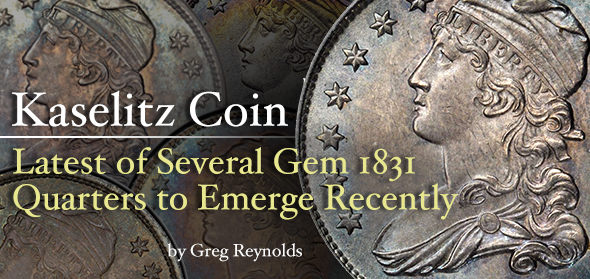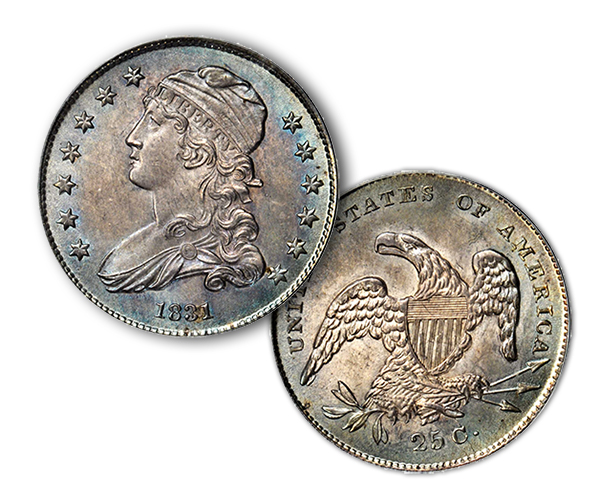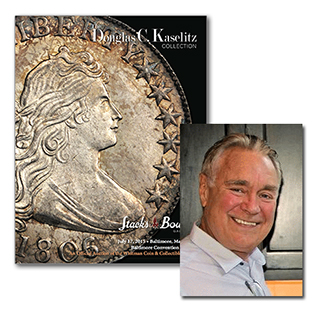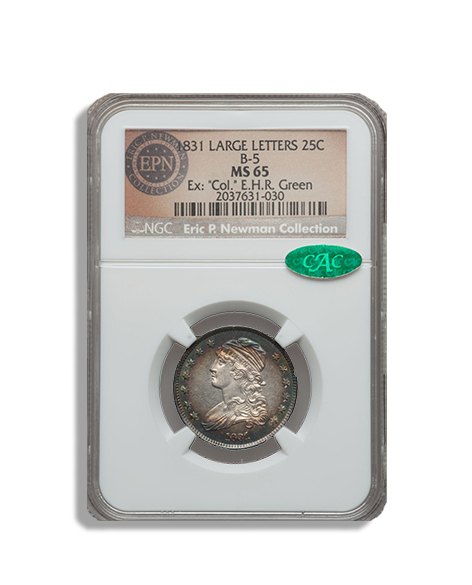
News and Analysis regarding scarce coins, coin markets, and the coin collecting community #285
A Weekly CoinWeek Column by Greg Reynolds….
On July 17, in Baltimore, Stack’s-Bowers will auction the highly rated, gem Douglas Kaselitz Collection 1831 Capped Bust quarter, and a lesser grade 1831 quarter will be in the same session. It is astonishing that multiple, certified MS-65 to “MS-67” grade, 1831 quarters have appeared in auctions from November 2013 to July 2015, including three different 1831 quarters that are each PCGS graded MS-66! These are important condition rarities.
On May 19, four 1831 quarters in the Pogue Family Collection were auctioned by Stack’s-Bowers in association with Sotheby’s,” a sale that contained the all-time greatest set of Capped Bust quarters. Earlier, Doug Kaselitz had attempted to obtain one of the 1831 quarters that became part of the Pogue Collection. Among the most ‘talked about’ coins over the past twenty-four months are 1831 quarters.
It is true that 1831 quarters are not rare. They are not even ‘better dates.’ They are type coins. In a sense, 1831 quarters are first year issues as the second type of Capped Bust quarters is dramatically different from the first type, which dates from 1815 to 1828. Some discussion of the first type is provided in recent coverage of the 1820 quarters in the Pogue Collection.
John Reich designed the first type of Capped Bust quarters. It is misleading to refer to the first type as ‘large’ and the second type as ‘small.’ It is true that the specified diameter for the first type is seventeen-sixteenths (17/16) of an inch (1.0625) and that for the second type is nineteen twentieths (0.95). Nevertheless, the difference in diameters is secondary to the concept that the two types of Capped Bust Quarters are really different designs by different engravers.
William Kneass reworked Reich’s designs to the point that the second type could be fairly regarded as his creation. Kneass Capped Bust quarters, the ‘small size’ issues, date from 1831 to 1838. Although all 1831 quarters are of the Kneass ‘Small’ design, there are two major varieties of 1831 quarters, ‘Large Letters’ and ‘Small Letters.’
The sizes of the letters on the respective reverse (back) designs are different. While some people who collect Capped Bust quarters ‘by date’ decide to treat these two varieties ‘as if’ they are each distinct dates, the difference is minor and pertains to the reverse. A set may be complete with just one 1831 Capped Bust quarter, unless all die pairings are sought.

The Kaselitz 1831 quarter
Collecting by ‘die pairings’ or even die states is a distinct topic for science-minded specialists in the series. Most buyers of Capped Bust quarters collect ‘by type’ or ‘by date.’ Only a small number collect by ‘die variety,’ though those who seek ‘die pairings’ tend to be extremely studious and dedicated.
Although the first issues of a design type tend to be slightly more appealing to ‘type collectors’ than later issues, most collectors who assemble type sets would be content with any Kneass (‘Small’) quarter, dating from 1831 to ’38. More ‘top of the line’ 1831 quarters have been ‘in the news’ in 2015 than ever before.
The Kaselitz Collection, PCGS graded MS-65 1831 has a gold sticker from CAC. A gold sticker means that experts at CAC have determined that this coin is undergraded in their view, and its true grade is at least in the middle of the range pertaining to the next grade increment. In this case, experts at CAC are indicating, with a gold sticker, that the grade of this Kaselitz 1831 is at least in the middle of the MS-66 range.
This PCGS graded MS-65 1831 has ‘Small Letters.’ In the same auction session, there is a ‘Large Letters’ 1831 quarter, which seems to also be in the Kaselitz Collection. This second 1831 is PCGS graded MS-62 and has a CAC sticker. Usually, Kaselitz was not interested in 62 grade coins. The Stack’s-Bowers cataloguer notes that the PCGS label (‘insert’) “incorrectly” refers to this coin as being of a ‘Small Letters’ variety. There really is not that much of a difference. Specialists in die varieties will note that the PCGS graded MS-65 coin is of the B-4 die pairing and the PCGS graded MS-62 1831 is of the B-5 pairing.
Although some die pairings are much rarer than others, neither a ‘Large Letters’ 1831 nor a ‘Small Letters’ 1831 is rare overall. In all grades, well over five hundred of each major variety survive. On the whole, there exist more than 2,500 1831 quarters. These, however, are condition rarities in grades above MS-64.
Of all varieties of 1831 quarters, there probably exist ten to fifteen that merit a MS-65 grade, and five to seven that truly should be graded MS-66, including one or two that may merit a ‘MS-66+’ certification. The totals in PCGS and NGC data include repeated resubmissions of some of the same coins and a few doctored coins that were mistakenly assigned numerical grades.
Douglas Kaselitz
Douglas Kaselitz died early this year. His wife or his family consigned his collection to the upcoming Stack’s-Bowers event in Baltimore. All of Kaselitz’s coins will be auctioned during the evening of Friday, July 17th. His paper money will be in a different auction session.

The Douglas Kaselitz Collection contains an assortment of items. The core is high quality type coins, especially those that are relatively original and eye appealing for their respective grades. The Kaselitz Collection contains too many gem quality type coins to sensibly list here, most of which are CAC approved. I have not yet seen them.
A PCGS graded and CAC approved MS-65 1814 large cent will attract bidders. An 1840 cent is PCGS certified as ‘MS-65-Red’ and is CAC approved as well. Various Indian cents in the collection are PCGS or NGC graded as MS-65 or higher, a few with ‘full red’ (RD) designations. The same is true of his Two Cent Pieces.
Doug Kaselitz was very fond of naturally toned, gem quality nickels. His collection contains Three Cent Nickels, Shield nickels, Buffalo nickels, and a Jefferson nickel that are highly certified and colorful. His 1942 ‘war nickel’ is PCGS graded MS-67 and has toned vividly. Until very recently, this 1942 was in one of Kaselitz’s large plastic holders, with screws, for type sets. It, along with some of his other type coins, may have been recently PCGS graded and never submitted to CAC.
Within the last three years, Richard Burdick brought seventy-six of Kaselitz’s coins to CAC. Seventy-two of those seventy-six were CAC approved. To be considered at CAC, a coin must have already been graded by PCGS or NGC. Therefore, Kaselitz’s uncertified coins were not then submitted, though perhaps most of those have been sent to PCGS since his coins were earmarked for public auction.
There are many gem quality Liberty Seated coins in this collection and more than a few exceptional bust silver coins. An 1805 dime that is PCGS graded “MS-66+” and CAC approved will command attention.
There are also many desirable coins that are certified as grading MS-64 or MS-63 in this collection. Kaselitz was not striving to acquire the highest graded coins that he could afford. He was much more interested in surface quality, originality and eye appeal than in numerical grades.
Richard Burdick and Kaselitz were “very close friends” for the last ten years. Richard had “known him over 40 years. He was a real numismatist first and an investor second. His primary interest was enjoying the coins. He usually avoided dipped coins. Doug was enthusiastic about studying the art, history and quality of coins; he very much liked unmolested coins. Doug preferred gem quality coins with nice toning,” Richard emphasizes.
Kaselitz began collecting coins before he was ten years old. Starting when he was around thirteen, Kaselitz spent considerable time at a coin and stamp store in Grosse Pointe, Michigan. According to Burdick, “Roman owned the shop, was Doug’s mentor.” Richard cannot remember Roman’s last name.
Roman taught Doug to distinguish natural toning from artificial toning, among other skills. “Roman would put two coins in front of him, one was that original and one that was artificially toned and ask Doug to tell,” Richard recollects.
Over the years, Kaselitz studied many coins and did much research. “Doug was one of the last self-educated, great collectors from the pre-slab era. He did not need PCGS or NGC holders,” Burdick asserts.
It is significant that Kaselitz would often attend auctions for educational purposes. “Many times, he would spend hours looking at the auction lots and not buy anything,” Richard remembers.
Burdick is certain that Kaselitz attended the Stack’s sale of the Reed Hawn Collection of half dollars in 1973, “at least two of the Garrett sales by Bowers in ’79-’80, and the Eliasberg gold sale in 1982.” He carefully examined many of the coins sold in these sales. Later, Kaselitz devoted much time to developing his real estate business and raising a family.
More than twenty-five years ago, Kaselitz bought the coin and stamp store that meant so much to him when he was a teenager. This store is still in business.
1831 quarters play key roles in friendships
Richard’s friendship with John Albanese began with the transaction of an 1831 quarter and Burdick’s friendship with Kaselitz was “rekindled” later when they both bid on this same 1831 quarter. For Richard’s own personal collection, Richard bought a gem quality “1831 quarter from Andrew Sydlak in 1982 for $3,000. Sydlak had paid $2.50 for it in 1938,” Richard is sure.
During the mid 1980s, while at a coin show in Kalamazoo, Michigan, Burdick met John Albanese by chance. John already knew of Richard. “John said he heard I had some really nice coins. I said they were not for sale. He said please show them to me, anyway,” Burdick reveals.

So, Richard brought them to this show the next day, a Proof 1855 half dime, an 1805 dime, an 1831 quarter and a 1799 eagle ($10 gold coin). Albanese was delighted with the coins and asked for prices. Richard did not want to sell any of them.
Finally, John talked Richard into agreeing to sell one of the four and Richard parted with the 1831 quarter, for $15,000. “I remember begging Richard to sell me the quarter,” Albanese now exclaims. “I was incredibly excited!”
The Sydlak-Burdick-Albanese 1831 quarter was later part of the incredible type set of James Lull, which Spectrum-B&M auctioned in Fort Lauderdale on January 9, 2005. I covered that sale for Numismatic News newspaper.
“In 2005, I needed it for the Pogue Collection. So, I had a strong bid,” Richard reports. “I won it for 36k plus the juice [$41,400]. Doug walked up to me and put his arm around my shoulder. He told me that I outbid him for that ’31 quarter. He was upset. I told him I had to do it and I would find him another gem ’31 quarter. Three years or so later, I did,” Richard relates. Burdick assisted Kaselitz in obtaining the already mentioned PCGS graded MS-65 1831 quarter in this upcoming sale, which now has a CAC gold sticker.
The Sydlak-Burdick-Albanese-Lull-Pogue 1831 is PCGS graded MS-66 and CAC approved. On May 19, 2015, it sold for $55,812.50.
Andrew Sydlak was a chemical engineer for Ford Motor Company. He died in 1998, according to Burdick. Sydlak acquired many gem quality type coins during the 1930s, ’40s and ’50s. He sold some of his best coins to Richard during the 1980s.
Future Pogue sales will contain a few coins that Sydlak owned in the past. The 1805 dime that Richard did not sell to Albanese in the 1980s was earlier owned by Sydlak and was in the Pogue I sale on May 19, 2015.
Recently Auctioned ‘Gem’ 1831 business strikes
 Though PCGS graded MS-65, John Albanese suggests, in a response to my inquiry, that the grade of the Kaselitz 1831 is in the high end of the 66 range. The already mentioned Sydlak-Burdick-Albanese-Lull-Pogue 1831 (B-4) is in the same league. Indisputably, its grade is at least in the middle of the 66 range. The collector known as “Link” now owns this coin and it is in his PCGS registry set.
Though PCGS graded MS-65, John Albanese suggests, in a response to my inquiry, that the grade of the Kaselitz 1831 is in the high end of the 66 range. The already mentioned Sydlak-Burdick-Albanese-Lull-Pogue 1831 (B-4) is in the same league. Indisputably, its grade is at least in the middle of the 66 range. The collector known as “Link” now owns this coin and it is in his PCGS registry set.
Although the Newman-Green 1831 is NGC graded as “MS-67+,” quite a few small contact marks and more than a few hairlines on the coin bother some experts. After being dipped, it did not naturally retone quite as well as some of the other bust quarters in the Newman Collection. Though certainly a gem quality coin, the “67+” certification is puzzling.
Many collectors would probably rather own the Sydlak-Burdick-Albanese-Lull-Pogue 1831. Although the Newman 1831 is flamboyant, it has a number of imperfections that give some connoisseurs pause at the assigned “67+” grade. In November 2013, the $117,500 result was an extremely strong price.
The Sydlak-Burdick-Pogue 1831 (B-4) is slightly finer than the Gardner-Morgan 1831 (B-4), which is also PCGS graded MS-66 and CAC approved. Its grade is in the middle of the MS-66 range.
Although the Newman-Green piece has more eye appeal than the Gardner 1831, Gene’s coin scores higher in the technical category. It is virtually flawless.
The Gene Gardner 1831 was auctioned by Heritage in June 2014. Before Bowers & Merena sold the exact same coin during November 1998, it was probably in the collection of Craig Morgan, MD. This doctor was assisted by Scott Travers in acquiring an incredible assortment of gem quality coins, including superb, late 19th century silver coins that are well remembered more than seventeen years later.
 The Gardner-Morgan 1831 was NGC graded MS-66 when it was auctioned for $17,250 in November 1998. In June 2014, it brought $47,000.
The Gardner-Morgan 1831 was NGC graded MS-66 when it was auctioned for $17,250 in November 1998. In June 2014, it brought $47,000.
There was a PCGS graded MS-66 1831 (B-4), without a CAC sticker, in Heritage’s Summer FUN sale of July 2013. It is in a relatively recent PCGS holder. I believe I have seen it before; I just cannot recollect the circumstances of such a sighting. It sold for $52,875.
On May 19, the Madison-Pogue, PCGS graded MS-65 (B-2) 1831 brought $39,656.25, deservedly more than the “Thomas”-Pogue PCGS graded MS-66 1831. The Madison-Pogue 1831 was formerly in the epic Madison type set that Heritage auctioned in January 2008. Although not quite as original as the Sydlak-Burdick-Pogue coin, the Madison-Pogue 1831 is neat and attractive.
On August 3, 2012, Heritage auctioned a NGC graded MS-66 1831 (B-4). It was moderately to heavily dipped long ago, and is still unnaturally white, though has naturally retoned to a noticeable extent with light russet and pale green hues. Although it scores highly in the technical category, some mint-caused imperfections are annoying. Its grade is in the high end of the 65 range.
The Sydlak-Burdick-Albanese-Lull-Pogue, Newman-Green and Gene Gardner coins are all clearly superior to the other PCGS graded MS-66 (B-1), “Joseph Thomas” 1831 quarter in the Pogue Collection. It is noteworthy that the Sydlak-Burdick-Pogue 1831 realized far more, $55,812.50, than the “Thomas”-Pogue 1831 (B-1), $35,250, although they were each assigned the same numerical grade by PCGS. If the “Thomas”-Pogue 1831 really merited a MS-66 grade in the views of pertinent experts, it would have realized at least $43,500. I could not bring myself to grade it as even MS-65.
Business strikes of the ‘Large Letters’ varieties are much scarcer than those with ‘Small Letters.’ Eric Newman had one of the best 1831 ‘Large Letters’ business strikes, possibly the finest.
The Newman ‘Large Letters’ 1831 is NGC graded MS-65 and CAC approved. It was just moderately dipped and retoned nicely. This more than very attractive coin is colorful and alive! It is the most dynamic of all surviving 1831 ‘Large Letters’ quarters, and the best that I remember seeing. At $32,900, this coin was one of the better deals in the auction of Newman’s U.S. silver coins.
The Pogue Collection had a ‘Large Letters’ 1831 that is PCGS certified as ‘Proof-65-Cameo’ and is CAC approved. It brought $105,750. John Albanese was the successful bidder.
Never before in the history of coin collecting have so many of the finest known 1831 quarters been publicly offered during a period of less than twenty-four months! Amazingly, quarters in the Gardner, Newman, Pogue and Kaselitz collections all happened to become available.
©2015 Greg Reynolds




